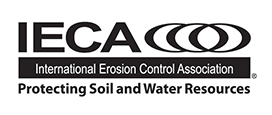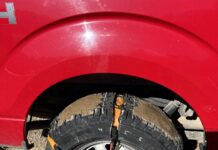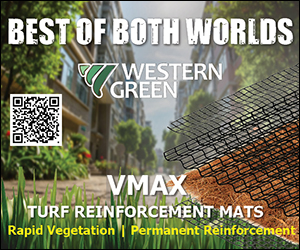By Jerald S. Fifield, Ph.D., CISEC
Years of conducting inspections have shown me that inlet protection methods are ineffective in capturing suspended particles in runoff waters discharging from active construction sites. Small amounts of sediment deposits may occur with pervious barriers in front of “sump” inlets. However, barriers in front of “on-grade” inlet openings divert runoff waters to downstream locations and may not effectively capture sediment. Considerations for improving inlet protection methods must occur if effective reductions of sediment-laden discharges into storm drain systems are to happen.
Sediment and erosion control (S&EC) plans should include inlet protection measures, as specified by EPA1 in their 2022 ConstructionGeneral Permit (CGP).
2.2.10 Protect storm drain inlets.
a. Install inlet protection measures that remove sediment from discharges prior to entry into any storm drain inlet that carries stormwater from your site to a receiving water, provided you have authority to access the storm drain inlet. Inlet protection measures are not required for storm drain inlets that are conveyed to a sediment basin, sediment trap, or similarly effective control; and…
Regulatory agencies, designers and contractors must keep in mind that temporary inlet protection best management practices (BMPs) have minimal effectiveness in reducing sediment discharges. This is due to the inability of these BMPs to create operative conditions to maximize the capture of suspended particles in sediment-laden runoff waters. Optimum effectiveness only occurs when storm drain waters discharge into a professionally designed sediment basin/trap.


Inlet Protection Methods
The predominate construction site method for inlet protection is the installation of barriers that create containment ponds to reduce inflow velocities. These barriers must be pervious, cannot float and be able to withstand the impact of flood discharges.
Subdivisions and commercial developments typically have multiple storm drain inlets. Only where “sump” conditions exist can development of “meaningful” containment ponds occur (Figure 1). Installing barriers in front of “on-grade” inlet openings divert sediment-laden runoff waters, which prevent the development of “meaningful” containment ponds to capture suspended particles (Figure 2).
Drainage problems associated with curb inlets also apply to area drains. Effective area drain inlet protection also requires the development of containment ponds at “sump” locations (Figure 3). In addition, installing inlet protection BMPs around “on-grade” area drains divert runoff waters unless containment occurs by downstream berms (Figure 4).
Barriers and Containment Ponds
Development of containment ponds at “sump” inlets occur when flow rates through pervious barriers are less than inflow rates. When pervious barrier flow rates are equal to or greater than inflow rates, or failure of the barrier occurs, development of “meaningful” containment ponds may not happen.
It is difficult to determine a percentage of effectiveness for “sump” inlet protection measures since concentration of suspended particles within inflow discharge waters varies with different construction phases. However, completing a general assessment of what may happen to inlet protection measures is feasible.


Assessing How Inlet Protection BMPs May Function
Evaluating the discharge zones of a sedigraph (Figure 5) allows for a “hypothetical” assessment of runoff waters entering a containment pond in front of “sump” curb or area drain inlet openings. Assuming the concentration of suspended particles within inflow waters remain constant and overflows of the barrier can happen, then:
• With Zone 1 discharges, deposition of larger diameter suspended particles (e.g., rocks, and sands) will take place within the containment pond until overflow conditions develop. Since the pond is not an effective sediment trap, most particles remain suspended in the runoff waters and discharge through the pervious barrier into the storm drain system.
• With Zone 2 discharges, increased volumes of sediment-laden waters flow through the containment pond and spill over the barrier. These flows have higher velocities that can remove deposits of small diameter sediments. The capture of larger diameter suspended particles (e.g., large sands and small rocks) may continue. However, most particles remain suspended within waters of the containment pond, which discharge through the pervious barrier and combine with sediment-laden overflow waters entering the storm drain system.
• With Zone 3 discharges, deposits of sediments increase within the containment pond as inflow velocities become smaller. It is within Zone 3 that large deposits of sediments will appear in front of pervious barriers. However, most sediments remain suspended and discharge through the pervious barrier into the storm drain system.
In summary, it appears “sump” inlet protection BMPs may have an extremely low effectiveness in capturing sediments from discharges prior to their entry into a storm drain system. Installing barriers in front of “on-grade” inlets will divert runoff waters, which also minimizes the capture of suspended particle from sediment-laden discharges.

Alternative Inlet Protection BMPs
Since most storm drain inlets within a development are located on streets having a grade, installing barriers in front of all curb inlets will not provide the effective capture of sediment from construction discharge waters. An alternative for “on-grade” inlet protection measures is to install pervious barriers within a development’s gutter flowline (Figure 6). These barriers must provide a tight seal with the asphalt/concrete, cannot float, and have a height that is about 25 mm (1.0 inch) lower than the top-of-curb.
Another inlet protection measure is installing inlet inserts (Figure 7) that capture suspended particles after flowing into an inlet opening. However, use of inlet inserts might violate EPA’s 2022 CGP requirements for inlet protection since they do not remove sediment from discharge waters “prior to entry” into storm drain inlets.
For either alternative, suspended particles in sediment-laden runoff waters will continue to enter the storm drain system. A third option that could address this problem is to professionally design, install and maintain a sediment basin/trap to accept construction site discharge waters entering a storm drain system. The 2022 CGP allows for this option. However, trash and debris control will be necessary for all inlet openings.


Summary
Installing inlet protection measures at curb openings are not effective methods for capturing suspended particles from sediment-laden discharge waters. Installing pervious barriers in front of “sump” inlets may be capturing only tiny amounts of sediment suspended in discharge waters. Pervious barriers in front of “on-grade” inlet openings divert runoff waters, which minimizes their effectiveness to capture suspended particles in runoff.
Increased effectiveness of inlet protection for developments may occur using gutter flow line barriers and inlet inserts. The most effective method for capturing suspended particles out of sediment-laden runoff is to discharge storm drain waters into an effective sediment basin/trap.
References
Environmental Protection Agency (EPA). National Pollutant Discharge Elimination System (NPDES) 2022 Issuance of General Permit for Stormwater Discharges from Construction Activities. In 01/24/2022 Federal Register, 87 FR 3522, Pages 3522–3532.
Fifield, Jerald S. 2011. Designing and Reviewing Effective Sediment and Erosion Control Plans. Forester Press. Santa Barbara, CA.
About the Expert
Jerald S. Fifield, Ph.D., CISEC, is actively involved with drainage, sediment and erosion control (S&EC), water rights and nonpoint pollution control. He develops S&EC plans, completes drainage analyses, provides inspection services and teaches about controlling sediment and erosion on construction sites. Jerry has authored professional papers, researched S&EC products and published S&EC manuals. He is also the founder of CISEC, Inc., which educates and certifies inspectors of sediment and erosion control.











